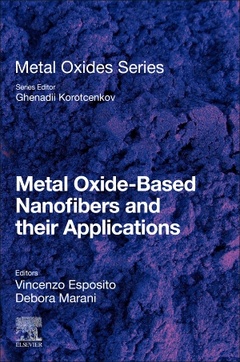Description
Metal Oxide-Based Nanofibers and Their Applications
Metal Oxides Series
Coordinators: Esposito Vincenzo, Marani Debora
Language: English
Subjects for Metal Oxide-Based Nanofibers and Their Applications:
Keywords
1D nanostructures; Advanced structures; Air pollutants; Air remediation; Anode; Band-bending; Battery; Biosensing; Catalysis; Catalyst support; Cathode; Centrifugal spinning; Ceramic materials; Chemical spray pyrolysis; Colloid electrospinning; Composite; Composites; Continuous fiber; Core–shell nanowires; DSSCs; Discontinuous fiber; Doping; Electrochemical biosensor; Electrochemical oxidation; Electrodes; Electrolytes; Electrospinning; Electrospun nanofibers; Energy harvesters; Enzyme immobilization; Fermi level; Fiber; Fibrous materials; Filter characterization; Filtration; Filtration capture mechanisms; Flexible displays; Fuel cell; Functional oxides; Gas sensor; Gaseous filter; Glass annealing; High-energy density; Liquid phase deposition; Manufacturing technology; Materials processing; Memristors; Metal oxide; Metal oxide nanofiber; Metal oxide nanofibers; Metal oxides; Metallatrane; Microlithography; Mixed ionic-electronic conductor (MIEC); N-type; Nanofiber electrodes; Nanofiber synthesis; Nanofibers; Nanogenerators; Nanolithography; Nanomaterials; Nanowires; Neuromorphic architectures; Nonelectrospinning techniques; Nonwoven fibrous filter; Organic electronics; P-type; PM filter; Perovskite; Photoanode; Photocatalysis; Piezoelectricity; Polymer; Resistive switching; Sensing mechanism; Sintering; Sol–gel process; Solid oxide fuel cell (SOFC); Solution blow spinning; Spinning; Storage; Supercapacitors; Thermoelectricity; Toxic gases; Water treatment
460 p. · 15x22.8 cm · Paperback
Description
/li>Contents
/li>Biography
/li>Comment
/li>
Metal Oxide-based Nanofibers and their Applications provides an in-depth overview on developments surrounding the synthesis, characterization properties, and applications achieved by scientific leaders in the area. Sections deal with the theoretical and experimental aspects of the synthesis and methodologies to control microstructure, composition and shape of the nanofibrous metal oxides, review the applications of metal oxide nanofibers in diverse technologies, with special focus on the relation between the structural, morphological and compositional features of the nanofibers, cover applications of metal oxide nanofibers in the fields of sensing (biosensing, gas sensing), and consider biomedical and cleaning technologies.
Lastly, a final section covers their application in energy generation and storage technologies (e. g. piezoelectric, solar cells, solid oxide fuel cells, lithium-ion batteries, supercapacitors, and hydrogen storage are reviewed.
Section 1 1 Fundamentals of electrospinning and safety 2 Special techniques and advanced structures 3 Nonelectrospun metal oxide nanofibers 4 Polymer-metal oxide composite nanofibers
Section 2 5 Metal oxide nanofibers and biosensing 6 Metal oxide-based nanofibers and their applications 7 Metal oxide nanofibers for flexible organic electronics and sensors 8 Role of metal oxide nanofibers in water purification 9 Metal oxide nanofiber for air remediation via filtration, catalysis, and photocatalysis
Section 3 10 Piezoelectric application of metal oxide nanofibers 11 Memristive applications of metal oxide nanofibers 12 Metal oxide nanofibers in solar cells 13 Metal oxide nanofiber-based electrodes in solid oxide fuel cells 14 Synthesis of one-dimensional metal oxide-based crystals as energy storage materials 15 Supercapacitors based on electrospun metal oxide nanofibers 16 Thermoelectrics based on metal oxide nanofibers
Debora Marani is an Independent Scientist in “Material Science with affiliation to the Centro de Engenharia, Modelagem e Ciências Sociais Aplicadas, Universidade Federal do ABC, Santo André (SP), Brazil. She obtained a master degree in Chemistry from the University of Rome “La Sapienza in 2002 and a “da Vinci Italian-French PhD in Materials Science from the University of Rome “Tor Vergata and Université Aix-Marseille in 2006. Over the years, she has been working on various topics in Materials Science in several academic environments in Italy, France, Japan, Brazil, and Denmark, often in close collaboration with the industry. Her scientific interest is in the development of innovative materials (ceramics, hybrids and polymers) and in their Energy and Environmental technologies applications.
- Reviews electrospinning methods for the synthesis and design of nanocomposites and hybrid metal oxide nanofibers
- Discusses applications of metal oxide nanofibers in sensing, biomedical fields, cleaning technologies, and energy
- Emphasizes the structural, morphological and compositional properties of nanofibers and their effect on device performance




